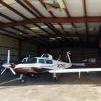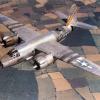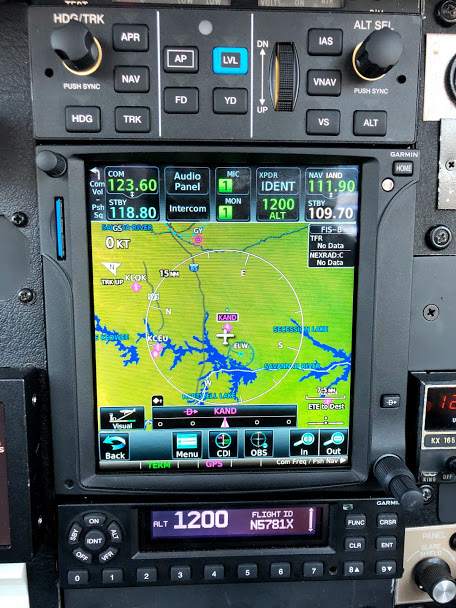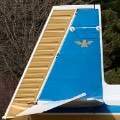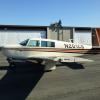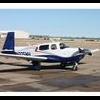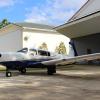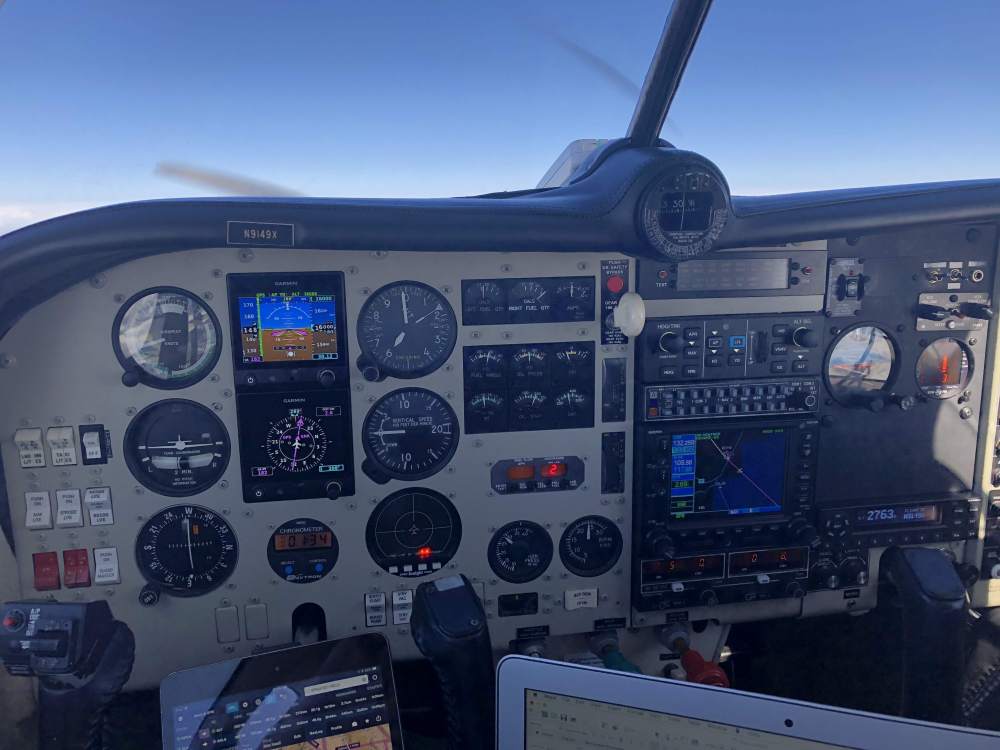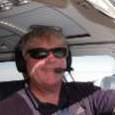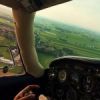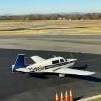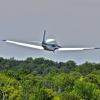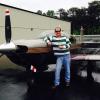Leaderboard
Popular Content
Showing content with the highest reputation on 03/28/2019 in all areas
-
It's here! A functional GFC500 in my Mooney 231 that I got to fly behind today! I wanted to share my first impressions on the new AP, although I will likely be adding on after this weekend (read more flight time). Before it went in, my 231 was equipped with a KFC150 with altitude preselect and VS mode which was tied into my G5 HSI and GTN750- no slouch of a setup to begin with. As such, my comparison baseline is against the KFC150. Today was a great day for playing- CAVU, nice and bumpy below 5000 or so and then smooth above. I flew it about 2 hours, mostly dropping the test pilot off at CLT to get home. (He's a MS-er, so he's A-OK in my book) We were able to do some maneuvers, demonstrations and approaches. First off, the ergonomics and annunciations on the AP control panel and the G5 are intuitive and took about 30 minutes to get used to. Button press pressure is just right- not too hard, but not too soft for turbulence. The annunciator colors on the G5 are also pretty intuitive. I really liked the TOGA feature- you're all set for a wings-level climb right out of the get go. Preselecting the heading, altitude bug and VS are simple and get you set up for a nice instrument departure should you need it. I unfortunately forgot to test the coupled go around- one of the things I was super excited for, more to come on that. The VS mode is so good at holding rate it's scary, even in turbulence. IAS climbs in turbulence were OK as the pitch hunted for airspeed a little, but was awesome in the smooth air above. I'm sure I'll find it immensely useful in the summer when wanting to keep the engine cool in the climb- it's HOT in SC. 1,000 and 200 foot alerts are standard and really nice; you can also set the bug to minimums on an approach and it will aurally and visually alert you- yes, basic but still nice. Altitude hold? None of this 10 -20 feet off BS. It holds right on the money even in turbulence- it's digital after all and computers are binary. I didn't get to play with VNAV yet unfortunately. For lateral guidance, the heading mode exhibits smooth and consistent rates in addition to very good rolls in/out of turns. Nav mode tied to a GPS? Native GPSS? Yep. intercepts and course holding is where you would expect it- rock solid and on point. in turbulence, the roll axis doesn't wallow all over the place like a rate-based AP, that thing is rock solid like the 150 was- a very comfortable ride in bumps. ESP- I got to try out the envelope protection in the areas of of slow speed and over-bank angle. the stall protection is very cool as you can really feel it pushing the stick below about 70 kts or so, just as the stall beeper is going off. Steep turns are my jam; and cranking it over on a wing, it starts engaging at 45 degrees and is really fighting you at 50 degrees to get to a more reasonable angle- again kind of useful for those IFR hand flying distractions. Unfortunately it won't save you from an accelerated stall- so you need to continue watching your airspeed base-final. I think LVL mode also belongs in here- I was in a descending (or maybe ascending, I don't exactly recall) turn and I hit the LVL button- that AP meant business getting the airplane back to straight and level. It was a little uncomfortable, but hey, if you're hitting that button, you're likely in a jam and probably need aggressive responses. Approaches- I messed up the AP on the approach to GMU by hitting the AP key instead of APR key (dummy) but after realizing it (or maybe being nudged by the test pilot, whatever), I was able to re-engage the AP on approach and the AP recaptured the GS- Nice! CLT gave us a visual approach, so we loaded the 36R visual into the 750, and oh yes of course the AP can capture and couple like an ILS- kind of fun! I ran a real ILS back at my home drome and gave it a nice 70 degree intercept about a half mile from the localizer at 140 kts- only slightly overshot the localizer (less than a dot) but intercepted it and stayed rock solid down to minimums. My favorite feature that I didn't think I would ever value- the Yaw Damper. Today's turbulence (not too bad but still there down low) was a good test. I could not believe how much it smoothed things out. We induced some yaw oscillations and hit the YD just as the ball was in the cage- Boom; dead stopped. On my descent back home I tried YD on and off and when the bumps came- it was a big difference. Overall, I'm very impressed. The biggest shortcoming to me is that the airplane didn't come back with a G3X. Lastly and as a side note, the Garmin team and products are first rate, but you all probably knew that. Working with the people there was a really good experience. Yes, there were delays which was annoying, but they were all more or less because of the need to redesign some stuff (brackets, sprockets, etc.) to get it right- something that we all can appreciate in the long run.18 points
-
I'm not sure what a little Timmy is? I am alive and well. Stuff has been happening in my life. I was promoted at work from a 9-1-1 dispatcher to communications supervisor so I'm now up to 60 hours a week. I normally browsed MS on my laptop at work but that died and what little time off I split between sleeping and flying. I scheduled my IFR checkride- twice, and the weather bunked it, twice. Before I could reschedule she turned into a pickle with annual expiring as well as registration. The Gov't shutdown meant I didnt get my updated registration until February. After that came back, I went into annual and found out I had to replace two cylinders. I *just* got done with the break-in and all is well. Post-SnF I'll be scheduling some refresher lessons and rescheduling my IFR. I'll post some update pictures and stuff for you guys.9 points
-
In a few years some of these folks who are now going to install full G3X systems with GFC500 are going to sell and never recoup their investment. And I'm going to have myself a bargain :-) @gsxrpilot put me at ease also with this analysis. I bought the 231 with an existing NGT9000+. I'm about to swop out my 430W for an IFD440 for under $5000. My Century 2000 is rock solid and my KX155 too. With the addition of an Aspen PFD Max ($10k) and a PMA450B I'll have a great setup at a fraction of a full G3X+GFC500 install. The rest of the money goes towards actual flying experiences. Those cottages at Staniel Cay aren't cheap.5 points
-
I would ignore most shop quotes for the next 9-12 months since we're in the ADS-B crunch right now and they're all very busy. If you absolutely have to do a new panel or A/P soon...be prepared to pay a premium. Sent from my LG-US996 using Tapatalk5 points
-
I just stumbled onto this post from 9 months before I took delivery of my m20f and four four years before the engine quit at 200ft. The strategy I had planned months before buying the airplane worked out for me when I had to put it down.5 points
-
One of them looks a bit like Faye Dunaway.....actually she looks like she ate Faye Dunaway. Maybe these gals are the answer to this topic’s question, “whatever happened to so-and-so?”4 points
-
Looks like your J is a 1986. If your POH is the 9-6-83 version, the Best Power and Economy Power definitions are at the top of the Cruise Power Schedule pages in the Performance section. Best Power is 100 dF ROP EGT and Economy is defined as 25 dF ROP EGT.3 points
-
Indeed, but no one should feel bad for Bennett. From what I can tell, he's enjoyed a long and adventure filled run. Probably longer than most in aviation. I'd bet that no matter how challenging, he is making the best of his current situation...3 points
-
Go to the Savvyanalysis.com site and read their Flight Test Profiles section under the Learn More tab. Follow their instructions and send the resulting data file in with a request to have it analyzed by them. I have found it usually takes less than 24 hours to get a response back from them with all kinds of good information. The profile they have you fly stresses several systems in your engine and helps identify where problems are occurring or likely to occur, and the resulting report is very specific.3 points
-
@carusoam, My KFC150 computer, VS/preselect, and 256 FD/AH will be available for sale in the next week or two to help get someone by until they can get themselves a GFC500. I’ll give the MS community first shot in the classified section before eBay.3 points
-
Hi guys, Just as my fellow Mooney pilots advised on this post, I pulled new RG 400 from the base of the horizontal stabilizer to the top of it by attaching the new to the old. I put the two ends together, applied a piece of heat shrink, then wrapped one side with .020 safety wire, brought a piece across to the other side and wrapped it. Then I put some electrical tape over the joint to make it smooth, tested the strength and pulled it through. There may be grommets in the vertical stab ribs but it went through just fine. The hardest part was tightening the nut on the upper AN742 clamp that holds the coax in place. It was a real ball buster with difficult angles. I also installed a new cat whisker antenna with an internal balun and BNC connector.3 points
-
Not that I'm a stalker or anything, but it looks like the J/K testbed for the GFC500 is on the way home. Looks to my uneducated eyes like Garmin is done with testing for our J/K models. I hope that means we will be added to the supported list soon (a month?). I'll expect a full report from the owner on how he likes the way it flies.3 points
-
As part of my panel project, I installed a Garmin AOA in the plane. It seems to work well and I was happy with it, but I experienced a problem on a flight on Tuesday that makes me question the safety of the installation. On take off my door popped open. No big deal- fly the airplane. The issue I have is that the Garmin AOA indicated an imminent stall both on the indicator mounted on the glare shield, and with audio alerts. Wind was crazy, lots of noise, and the AOA made the situation worse. I pulled the breaker, landed, and closed the door. With the door closed, the AOA began working as expected. Investigating the issue, it appears that the GSU 25 uses three connections to determine Angle of Attack. There are two air connections to a dedicated pitot tube, and a third to the static system. The installation manual prohibits connecting the GSU 25 to the static system of the airplane. Instead, the static connection is placed near the alt static source behind the panel in a Bonanza. When the door opened on takeoff, I believe it created a low-pressure condition inside the airplane. The low pressure caused the AOA to mis-read the AOA and to direct the pilot to reduce the angle of attack, even though the wing was flying safely. Given that this indication occurs during a critical phase of flight after a common problem with general aviation aircraft, I believe the Garmin AOA can adversely contribute to safety in this condition. I notified Garmin of this problem yesterday and we're working through the problem. I'm not sure I have any options given the approvals for the system; this failure condition may be a feature rather than a bug. At the very least, pilots should be notified of this potential problem. I believe that the GSU 25 should be connected to the static system of the airplane for this installation to be safe. I’m evaluating options at this point, but my first reaction is to remove the system if it can’t be connected to the static system of the airplane.2 points
-
I have become convinced that my inability to land well consistently is my inability to know exactly how high I am. I have flown with a very good CFI who tells me exactly when to flare, and it works better than when I am making the decision. I find myself getting to the correct speed, getting to where I think I am the correct height above the runway, flaring and waiting for it to get to the surface. And often, it doesn't happen when I think it will. I have tried looking down toward the end of the runway, looing at the ground close in front of the plane, and trying to watch out at an angle out the side of the windshield. In each case, sometimes it touches down when I expect it to, sometimes it touches before I expect it to, and sometimes it keeps dropping a second or two longer than I expect.2 points
-
Exactly! Frankly, I think a lot of people make it sound like there is something exotic or unusual about many aspects of flying a Mooney. It's just another single engine, four place, low wing, retractable gear airplane. As I tried to point out earlier, the range of approach speeds varies with weight - the same as any airplane - but not nearly so much as some seem to believe. Low wing planes float more than high wing, and Mooney's float more than most low wings because the wing is closer to the ground. My observation as a CFI has been that many people try to land too fast regardless of type. Mooneys just float more when you do that making them seem different. A really good exercise is to cover the airspeed indicator and fly around the pattern without it. It's not that hard and will cure you of fixating on the airspeed once you get comfortable with it. Find an experienced instructor and try it if you've never done it before. Skip2 points
-
Finally got my Bravo back from Garmin. I picked it up last Friday and have put about 10 hours on it so far. I’m really enjoying the GFC 500. It is very smooth. It doesn’t wander back and forth when intercepting or making turns. The level offs are very smooth. I like that I can adjust the altimeter setting and the autopilot gently captures the new altitude without having to re-engage v/s mode. The yaw damper is great. Great in turbulence and no need to use the rudder trim anymore for climbs and descents on the autopilot. Airspeed climbs and descents work ok but not in turbulence, the airplane is too light and make rather aggressive pitch changes to airspeed fluctuations I haven’t had a chance to fly any approaches yet. Maybe this weekend. Overall I think the GFC 500 is much better and easier to use than the KFC 150.2 points
-
I read through most of the posts and I have a few recommendations. Everything you are trying to sort through is dependent on your fuel flow being correct and all of the other factors are applied correctly (FF, degrees ROP, OAT, power settings, etc.). The later model Mooneys have more detail on the power settings and expected fuel flow. In carusoam style: - Calibrate your k factor so that is dead on. If you need a sounding board, let me/us know. I have mine dialed in. The key is to be accurate on how much fuel you add and calibrating using sizable fuel usage. If my FF is off more than 0.1 GPH, I would be surprised. - The % HP value is nice to be able to quickly set power. Mine is off ~4%. I’m just too lazy to update it. - As mentioned earlier, download the Savvy flight profile stuff and fly it. It will check your GAMI spread and also do the inflight mag check. I would use their analysis tool to check the results. - I think Savvy still has a free analysis service. I would get all of the stuff set up correctly above and then fly long enough for them to look over the flight data. If it isn’t free anymore, I highly recommend the $129 service they provide. It has helped me a few times diagnose weird stuff. Here are the POH tables for the F model. It has various altitude and power settings for you to benchmark on. Sent from my iPad using Tapatalk Pro2 points
-
Yes, I always cruise LOP. Even short hops but nothing I do is really down low. My airport is at 3,000 MSL with density attitudes often above 5,000 ft., sometimes much higher. That's an advantage of a higher horsepower engine in a relatively slick airframe. You still get reasonable cruise speeds LOP on reasonable fuel flow. Starting at 200 HP versus 285, it is tough to go fast enough at altitude to make many people happy when LOP so they start flying ROP. My personal threshold is 160 KTAS. As long as I can get at least 160 KTAS in cruise, I'll fly LOP and I have been able to do that in my last few airplanes.2 points
-
@NJMac, in looking back over your initial pics, I have to ask if there is something out of whack with your EDM 900. I ask because I see you have 116 gals. used in one photo and 496 gals. used in another. Is that a result of not resetting when you fill up or what? Or do you have the extended, extended range tanks?2 points
-
Garmin seems to be pushing the idea that the VFR GPS in the G3X, while not legal to shoot an IFR approach with, is better than no second GPS or a portable if you lose your (e.g.) GTN 650 in the clouds. I think, as a second backup, the GNC 255 makes more sense. Gives you a second radio, VOR, and ILS if you lose the GTN and you have the integrated VFR GPS as an advisory tool. I think that's likely to end up being my radio stack since I already have the GTN 650.2 points
-
The engine monitor shows 13.5 GPH. For a 200 HP normally aspirated engine that's a tremendous fuel flow. I cruise at 12.5 GPH with a 285 HP engine.2 points
-
2 points
-
Not really, but just looking at you OAT range -7 to 25 tells me you really can’t compare different flights. You need to go up, lean the engine from rich to lean...slowly, then upload data to savvy. Use their gami find functionality to get your fuel flow spread. Tom2 points
-
What the FAA WAS doing and what they ARE doing are very seldom lined up. The PA-32 and 180/182/185 paperwork was submitted in November, and at that time they were expecting a 4-6 week approval time. Then some people at the office they were working with quit or were transferred, and they changed the quoted approval time to 6-8 months. Of course, the government shut down didn't help things. 2 weeks ago today they were told something along the lines of, "your approval will be issued today." Now they are on a, hopefully slight, hold due to the Automatic Envelope Protection because of the 737 Max issue with the auto pilot. I am sure they have the Mooney paperwork ready to submit, or at least very close to ready, and hopefully it won't take as long this time, but when you are dealing with the government, they will do it when they do it. You know the slogan, "We're not happy until you're not happy." Well, we're all not happy, so we just need to wait until they realize this and then become happy.2 points
-
It's not actually, because the KI256 is still running the autopilot. And the autopilot is flying the plane. With a G1000, it's driving the autopilot and flying the plane. The backup instruments are there in case the G1000 goes dark. The G3X/G5/GFC500 is a great system. But without the GFC500, it's just handicapped.2 points
-
2 points
-
so will the second hand market on 20 year old used GNS430's finally plummet to their rightful low value?2 points
-
Note to self... don’t give IA logbooks that they could write in. They can print a sticker that may or may not find it’s way into the logbook.2 points
-
FWIW, I was by @AGL Aviationtoday. Lynn had a PFS exhaust disassembled on a worktable. He pointed out a small crack inside the junction of the headers. The PFS is off a flying school's C172 and has 2200 hours without any cost except inspections. The new part, which is essentially the whole guts of the system is $1200. (The headers are fine as is the tailpipe and heater shroud. I asked Lynn if he'd ever mic'd the wall thickness of the headers. "Yes, it is double that of conventional muffler systems.") If that's typical, $1200 over 2200 hours, I suppose the PFS system is cost competitive with conventional systems without appeal to performance (speed/HP) or CO safety considerations.2 points
-
DRILLING TIP NOTE: Windshields installed with flush screws through dimpled holes in the skin need special attention. When drilling the Plexiglas being held in place, the windshield will be resting against the dimpled upset-holding it slightly out of position. To compensate for this, the pilot holes #40 should be drilled to the outside edge of the existing holes. They will lineup after the hole is drilled full size and countersink! This prevents puckering of the metal on the finished job.2 points
-
So, for the OP, the suggestion is, keep the power up, keep the speed up, climb reasonably good and “git on down the road”! As far as CHTs in the climb go, Mooney and the FAA are (were) concerned with a point design condition. Us owner operators are more concerned about balancing performance and engine durability over the long term. So even though the airplane may pass the cooling climb condition flight test, we can smartly get most of the performance in climb rate and velocity made good, while being mindful of engine durability, by the suggestions here....cruise climb, maximum power, manage cylinder temps with speed and/or cowl flaps (in that order), target EGT. Hope this helps.2 points
-
Hi Hank and everyone I wish I had cowling pressure and cooling data! But thanks for thinking of me. My opinion is that the difference between true airspeed and calibrated airspeed can be thought of as a virtual tailwind, going from zero to a pretty decent number the higher you go (all other things being equal). So a cruise climb speed (or quantified cruise climb profile Vz, as many in this thread are using *thanks, it's really cool to see that* ) decently balances the climb rate versus velocity-made-good to the top of climb. The higher speed should help cooling, the Target EGT fuel flows were established to allow the airplane to pass the part 23.1043 requirements. But why is everyone having to work so hard to keep their engines cool in climb, when they are supposed to be able to stay in limits when flown as designed? Here is a stunning master's thesis that might have answers, the premise is that the FAA formulas for correcting flight test ambient conditions to standard may not be correct. https://repository.lib.fit.edu/bitstream/handle/11141/1138/STUTH-THESIS.pdf?sequence=1&isAllowed=y One of the advisors to this paper is my friend (and SETP Fellow) Ralph Kimberlin, with his guidance this thesis is one you can take to the bank. Happy reading!2 points
-
The G3X is pretty low profile. It's not like the G5 that sticks out from the panel. Having flown the TXI, I wouldn't flush mount it given the option. I use the edge of the screen to stabilize my hand when using the touch screen.2 points
-
I will report nothing and keep you all in suspense (first impressions and panel porn to be provided later today)2 points
-
I'm the one who was lucky enough to end up with Bennett's aircraft. Dan at LASAR, the head of parts, is a friend of mine, and he knew I'd been shopping for a M20J for a few months (including sending one to LASAR for a PPI that ended up showing unexpected corrosion). Bennett's Mooney was in at LASAR getting an annual inspection done when he made the decision to part ways with it. He mentioned to Dan that he'd likely be sending it down to All American Aircraft when the annual was complete. I gave Bennett a call, we chatted a while, and put together a deal. He was generous enough to have me come by his hangar after the sale closed to pass on a portable O2 system, spare parts, extra headsets, etc., that he no longer needs. A very kind soul.2 points
-
MyNameIsNobody was one of the few folks with very strongly held political and other views who I found amusingly grumpy, but not toxic. He often had useful info to impart as well. I do enjoy the civility here but hope there's still room for a few of those people. I worry about a dystopian future where even questioning the superiority of Garmin avionics will be declared hate speech and get me banned from the board2 points
-
Great list of down sides to the Garmin. It's cheaper than the TXI system, but you give up a few things to get the cheaper option. I have a 10" TXI display (with the EIS) and I wouldn't not say that the screen is anywhere near too large. There's a lot of info on that screen. I'm not surprised by the limitations of the G3X system. Wide compatibility is desirable, but it's not free. The closes system certainly does give Garmin the ability to capture more dollars from the aircraft owner, but it also gives Garmin the ability to more quickly test the systems and reduces the cost to bring them to market. TXI or G3X- pick your poison- or go elsewhere and take your chances. I'm on the record of what I think is going to happen to Aspen. Great product 10 years ago when it came out- revolutionary. Today- it's not competitive. 12 months ago when I looked at new planes I considered an Aspen the same as King AI/HSI. In the future- my money is that most buyers think about Aspen equipped airplanes exactly the same. Doesn't change the capability of an aspen equipped airplane, but I do expect it to change the desirability.2 points
-
Backup instruments are required regardless of one or two screens installed. This backup can be the G5, but regardless, a backup is required. No legacy autopilot support for anything other than heading bug. Fully coupled approaches will require the GFC500. No Navigator support other than Garmin. No Audio panel support other than Garmin. No Transponder support other than Garmin. Certain nice Garmin features like Database Concierge, and a few other features, not supported on the G3X. The hardware/video is legacy quality. "If you want the new modern video resolution, buy the TXi" Just like the GFC500 is a great new autopilot, but it's not quite the GFC600 level. The G3X is nice, but it's not TXi level and not meant to compete. I believe the Aspen competes very well with the top of the line TXi in everything except the large screen. And as @Cruiser said, to my eye, a lot of that screen is wasted real estate. If I was going G3X, I'd prefer two 7" screens anyway. To my eye, they're a better use of space. With two Aspen screens I have full revision and redundancy. With two G3X screens you have two screens. But you still require a third screen that is only used if something fails. With the Aspen, the MFD is my backup. If the PFD fails, the MFD becomes the PFD. And in an emergency situation, I don't need an MFD, I can certainly use an iPad for that, or my panel mounted GPS is also effectively an MFD. I've never like the idea of instruments in my panel that are ONLY there incase of a failure. I'd like them all do have a useful function. Anyway, just my $0.02. I've had a full helping of crow as well, and was about to call the avionics shop and cancel my Aspen MFD order. But after sitting through the webinar, and reading everything Trek posted on BeechTalk, I'm very comfortable with my decision to move forward with the Aspens.2 points
-
I have given up on all other boards except this one because of the drama. Life is too short to be arguing about Little Timmys and my appendage is longer than your appendage. Yeah, we ain't perfect but what family is?2 points
-
They replaced the part. I did not ask about whether welding is an option on the PFS.1 point
-
%bhp While ROP are a mysterious calculation... the calculation uses measuring the limited resource in the system... volume of air flow... a certain amount of fuel is used for cooling and the rest for power delivery... the engine manufacturers determine this calculation using a dynamometer (Dyno) with a highly instrumented engine... essentially measuring the limited resource, Air... MAPA took these numbers and simplified them for Mooney pilots... they call them key numbers... the simplification uses MP and rpm to define the %bhp. Be sure this collection of key numbers is an over simplification. Each Mooney gets a set of key numbers.... to best represent what you are trying to calculate... %bhp While LOP is less mysterious... all the fuel entering the system is being used to produce power. Measuring FF accurately is pretty easy... the calculation uses the engine’s compression ratio to personalize it some... JPI has had difficulty using a program to calculate %bhp for all engines ROP and LOP... Without an airflow meter, %bhp While ROP requires a look-up table... Do some reading from JPI, Find out how accurate the %bhp calcs actually represent your situation... For NJM... Find out how well calibrated your K-factor really is... For engine instruments this complex... verify first, then build trust... Reagan era philosophy regarding icbms was much easier... the Russians didn’t want to get killed either... your engine monitor has nothing to lose. PP thoughts only... not a mechanic. Best regards, -a-1 point
-
Thanks for the PIREP. I had a ride in a Cirrus with the Garmin AP and was also extremely impressed with the yaw dampener. I would definitely consider buying it with the dampener if it’s not too much. It makes for an extremely smooth ride especially with non aviator passengers.1 point
-
1 point
-
I think they meant lite speed Sent from my SM-G930V using Tapatalk1 point
-
Phil - my comment was directed at the adequate transponder coverage on the ground at the airport. Exactly how does that get done? Transponders are interrogated by secondary radar. Secondary radar doesn’t reach the ground. At airports where they have implemented ground radar for ground traffic control, this may be true, but I am not aware of any uncontrolled field that has ground radar and I doubt most smaller Class C & D have it as well. The ADS-B coverage map by altitude. https://www.faa.gov/nextgen/programs/adsb/ICM/ The ADS-B coverage map by services. https://www.faa.gov/nextgen/programs/adsb/coverageMap/ What I am trying to understand is how in a non-radar coverage area the snitch tape is recording on your ADS-B compliance failure. If you are not in radar coverage, are they saying the ADS-B towers are receiving something from the Skybeacon without the corresponding transponder response? How is that being accomplished when the transponder is not signaling the Skybeacon to trigger. Something doesn’t make sense and I am trying to understand. Sent from my iPad using Tapatalk Pro1 point
-
Please don't invite him back. He is giving us Cheap Bast%$ds a bad name. Who would have thought you could slice a piece of bread in half and make a sandwich with it? Raptor did. Why that Cheap Bast%$d!!1 point
-
Yep, based on the feedback here, the G3X offering has pushed many of us who were thinking about a G500TXi with a legacy autopilot into thinking about a G3X with a GFC500 for a little more money. That sounds like a pretty good business plan for big G.1 point
-
1 point
-
Yesterdays flight was another short hop to VCB dead calm at home but once underway we hit some pretty bumpy air. VCB was 21 gusting to 33 on arrival at about 30 degrees to 02 making for a pretty challenging landing. Heading into the wind going home slowed us down a bit and home was still dead calm. Surprisingly different winds at two locations so close together. Photo shows severe clear sky with snow on our local hills Mt Konocti has new vineyards going in which I don't object to since they make excellent fire breaks.1 point
-
1 point

